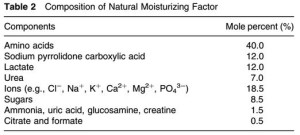Our stratum corneum contains free amino acids (remember those amino acids results from enzymes break down of fillaggrin? from this post), and other nature occurring chemical lactic acid, urea, and sodium PCA, etc. These are called “natural moisturizing factors” and are responsible for keeping the skin moist and pliable by attracting and holding water.
NMF are humectants; they attract and hold onto water. The water content of the stratum corneum is about 30%. The proteolytic breakdown of filaggrin to amino acids only happens when the skin is dry to control the osmotic pressure of the skin and the amount of water it holds. The need for breaking down of filaggrin is less in humid weather than in dry weather. When the skin is occluded (or when the relative humidity is high), there is minimal breakdown of filaggrin. Drier conditions lead to an increase in proteolytic activity, resulting in the production of more NMF.
In summary, when the water content in the SC is decreased it activate the proteolytic enzymes to break down filaggrin into individual amino acids. These plus other chemicals form NMF in the stratum corneum holds water to rehydrate the SC.
*Info & Image source: Handbook of Cosmetic Science and Technology*
The NMF concentration varies with age and skin depth. For healthy skin, not exposed to surfactant damage, the NMF content is independent of depth until one approaches the filaggrin-containing levels of the skin. In the deeper stratum corneum layers of older individuals (50-65 yrs) the NMF concentration is low. This is a reflection of the skin’s diminished ability to degrade filaggrin.
Some NMF behave as simple humectants and have other functions. Lactate and potassium, for example, affect the pH and stiffness of the stratum corneum. The L-isomer of lactic acid also stimulates ceramide biosynthesis and improves barrier function. Two additional NMF, Hyaluronic acid (HA) and glycerol, have also been found in the stratum corneum.
- Hyaluronic acid (HA), a nonsulfated glycosaminoglycan, is a hygroscopic polymer of repeating disaccharide units of N-acetylglucosamine and glucuronic acid. It is a well-known component of the dermis, maintaining its hydrated state and providing structural integrity. In the stratum corneum, it not only functions as a humectant but also interacts with the intercellular lipids and regulates the mechanical properties of the stratum corneum.
- Glycerol may be derived from the breakdown of sebaceous triglycerides or originate from the conversion of phospholipids to free fatty acids. Study has shown that skin hydration was only enhanced by the addition of glycerol.
Like HA, glycerol also influences the skin’s pliability by interacting with skin lipids. Glycerol could modulate the phase behavior of intercellular lipids favoring a more pliable, liquid crystalline structure at low relative humidities.
*Info & Image source: Handbook of Cosmetic Science and Technology*
